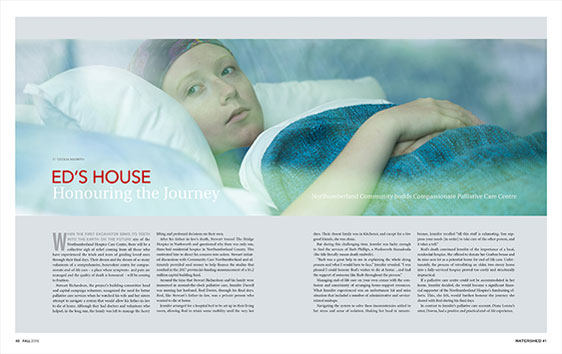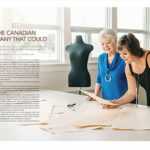
Northumberland Community builds Compassionate Palliative Care Centre
WHEN THE FIRST EXCAVATOR SINKS ITS TEETH INTO THE EARTH ON THE FUTURE site of the Northumberland Hospice Care Centre, there will be a collective sigh of relief coming from all those who have experienced the trials and tears of guiding loved ones through their final days. Their dream and the dream of so many volunteers of a comprehensive, benevolent centre for compassionate end-of-life care – a place where symptoms and pain are managed and the quality of death is honoured – will be coming to fruition.
Stewart Richardson, the project’s building-committee head and capital-campaign volunteer, recognized the need for better palliative care services when he watched his wife and her sisters attempt to navigate a system that would allow his father-in-law to die at home. Although they had doctors and volunteers who helped, in the long run, the family was left to manage the heavy lifting and profound decisions on their own.
After his father-in-law’s death, Stewart toured The Bridge Hospice in Warkworth and questioned why there was only one, three-bed residential hospice in Northumberland County. This motivated him to direct his concern into action. Stewart initiated discussions with Community Care Northumberland and ultimately provided seed money to help finance the studies that resulted in the 2017 provincial-funding announcement of a $1.2 million capital building fund.
Around the time that Stewart Richardson and his family were immersed in around-the-clock palliative care, Jennifer Darrell was nursing her husband, Rod Davies, through his final days. Rod, like Stewart’s father-in-law, was a private person who wanted to die at home.
Jennifer arranged for a hospital bed to be set up in their living room, allowing Rod to retain some mobility until the very last days. Their closest family was in Kitchener, and except for a few good friends, she was alone.
But during this challenging time, Jennifer was lucky enough to find the services of Barb Phillips, a Warkworth thanadoula (the title literally means death midwife).
“Barb was a great help to me in explaining the whole dying process and what I would have to face,” Jennifer revealed. “I was pleased I could honour Rod’s wishes to die at home…and had the support of someone like Barb throughout the process.”
Managing end-of-life care on your own comes with the confusion and uncertainty of arranging home-support resources. What Jennifer experienced was an unfortunate hit and miss situation that included a number of administrative and servicerelated mishaps.
Navigating the system to solve these inconsistencies added to her stress and sense of isolation. Shaking her head in remembrance, Jennifer recalled “All this stuff is exhausting. You suppress your needs [in order] to take care of the other person, and it takes a toll.”
Rod’s death convinced Jennifer of the importance of a local, residential hospice. She offered to donate her Grafton house and its nine-acre lot as a potential home for end-of-life care. Unfortunately, the process of retrofitting an older, two-storey home into a fully-serviced hospice proved too costly and structurally impractical.
If a palliative care centre could not be accommodated in her home, Jennifer decided, she would become a significant financial supporter of the Northumberland Hospice’s fundraising efforts. This, she felt, would further honour the journey she shared with Rod during his final days.
In contrast to Jennifer’s palliative care account, Diane Lorenz’s sister, Dawna, had a positive and practical end-of-life experience.
Happily ensconced in a St. Thomas retirement home, Dawna’s health suddenly declined to the point that she needed a level of care the facility would not normally provide. There was a very real chance she would have to leave the home where she knew everyone and was surrounded by her precious belongings and keepsakes.
Fortunately, the head of the facility stepped in. She arranged for oxygen to be brought in, purchased an air bed so loved ones could stay over, and accessed the palliative-care services of the local Community Care organization to assist with Dawna’s health concerns.
Diane can’t say enough about the people who were there for her sister day-by-day; they empathetically offered care and comfort, they were consummately professional, compassionate and knowledgeable individuals. “There were some good people there,” added Diane.
This overwhelming kindness impacted Diane significantly. Diane always felt that she and her husband, Ed, were blessed by the success of the family business, Lorenz Conveying Products. She wanted to pass along those blessings to others. After Dawna died, Diane and Ed were determined to give a significant donation to the hospice project. This donation proved to be the largest single endowment – a $1.5 million gift that inspired a new name for the facility: Ed’s House.
“It was an opportunity to do some good in the community – not just now, but for a long time in the future,” Diane noted.
Of course, there were others in the community who believed in the project and who were determined to make a difference in a big way. Kym and Brian Read donated $1 million through the Read Elliott Family Foundation to the hospice care wing that will house the six patient care rooms.
“With its combination of innovative design and professional services,” Kym stated, “this centre will bring comfort and dignity to the sick and dying. It will also be a wonderful facility for families to be together in a supportive environment during such challenging times.”
Stewart Richardson, Jennifer Darrell, Diane and Ed Lorenz, and Kym and Brian Read were all inspired by the emotional, yet positive experiences of Cobourg resident Doug McCann, whose wife Brenda moved into a Burlington hospice years ago.
As his wife’s illness progressed, he noted that his life was reduced to just two rooms in his house. People stopped visiting, and his world consequently turned upside-down.
The day came when Brenda’s nurse suggested a hospice. Doug still recalls the anguish that he and his wife experienced as they left their memory-filled home for the last time together.
But the welcome that the hospice staff extended allowed Doug and Brenda to live their final chapter of life together in comfort and tranquility.
“Our frowns and sorrow turned to excitement,” Doug said. “Brenda’s whole demeanour changed. She started to get brighter, was interested in her surroundings and her family and we could have conversations again. We were a family again.”
Once he caught up on his own sleep, Doug realized, with gratitude, that his role was changing from care-giver back to husband.
The amiable hospice environment attracted friends and family members to a homey place where they could sit comfortably, share memories and laughter. And behind the scenes, the doctors who served the hospice gave Brenda reassurance that she would be kept in physical comfort during her stay.
“She passed with dignity, and I got to experience that with her, which is very precious.”
Each person profiled in this story has experienced the same journey – they have lost a loved one – some with dignity and some, unfortunately, without. Their diverse experiences have come together in a common goal: a goal to bring compassionate end-of-life care to Northumberland where loved ones can die with dignity.
Although these stories are compelling, there are many others in the community who recognize the need for proper palliative care. Through their determined efforts, these unsung heroes are closing in on the $9.3 million goal to build a 24-hour-a-day, seven-day-a-week hospice care centre north of Cobourg. The need for a place like Ed’s House proves that the quality of death enhances the overall quality of life.
The Bridge Hospice: a Gift of Grace, Peace and Dignity
Not so long ago, the Warkworth community came together to ensure The Bridge Hospice would be there for people like Joy and Gary Woodcock. Joy now recalls their stay at the hospice this past spring as a time of grace, peace and dignity.
The Woodcocks had been managing at their Campbellford ho me with some help, but it eventually became too much for Joy to continue. Gary suggested they take a drive and check out The Bridge.
“They showed us through, and we decided, this is home. Your family can come to visit, you can sit on the deck for a drink. I can make cookies in the kitchen,” she recalled, sharing a quiet reminiscence in the facility’s comfortable living room.
Joy had not really accepted that her husband of 38 years – whom she thought of as young and strong – was going to die and brushed off all attempts to discuss the matter.
“It was here, through listening to all the doctors and nurses, and to Gary, that I came to accept that my husband was, indeed, dying. That was a gift to him, because we could start talking about our gratitude for our life and our family,” she said.
Joy found that acceptance actually brought them a completely new intimacy.
“Because we both could relax here in this beautiful home, there was nothing left unsaid. If eel that gift now, because I know that my husband received the best of care and love here.”
On one particularly memorable day they took a drive, and Gary finally taught Joy to parallel park. “It was a gift to him that he could still help his wife. He was still engaged, still my husband, still a man,” she recalled.
Gary’s spirits brightened so much, she wondered if he might actually recover and go home. He wisely suggested they give it another week or two. And in due course , the nurses taught Joy what to look for with Gary, what the body must do as its time approaches and how she could help.
“One day he could barely talk. I leaned into his shoulder on the bed, crying. I knew at that point he wasn’t going to come back. He got his hand up to the back of my neck and he comforted me. He said, ‘Joy, think of how lucky we are. So many people don’t have this.’”
The volunteers and nurses were always there, and never more welcome than during the last few days.
“They sat with me and Gary, hours on end. I was there at the very end with the nurses. It was not frightening, which it would have been otherwise.”
“We all die. The trick is not to die alone – and not to have someone with you who doesn’t accept your death, because then you truly are alone . They helped me come to terms with life, and with death. It was a gift for Gary, and for me.”
Story by:
Cecilia Nasmith


